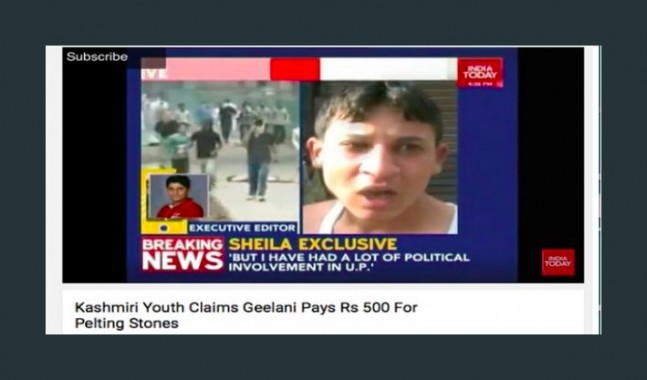Lying about Kashmir with old videos
In their coverage of the Kashmir protests, some channels recently used old 2010 footage to spread canards about the demonstrators. Hindi news channels Zee News and Aaj Tak and English channel India Today recently aired two videos to argue that Kashmir’s present crisis is sponsored by Pakistan and that Kashmiri mobs have been attacking Indian security forces.
In the first video they show a young Kashmiri boy in his undershirt, surrounded by a group of hostile CRPF personnel, crying and saying that “Geelani is paying their gang Rs 500 for throwing stones at Indian soldiers”. Rahul Kanwal, India Today’s anchor known for his pro-establishment views, took to Twitter to write this: “Newsroom on confession of a stone pelter who says he was paid money by separatists to spread mayhem in Kashmir.”
The video was of the 2010 demonstrations. It was run as an “exclusive” report in July 2016. Mufti Islah, a well-respected television journalist based in Srinagar, responded with this tweet: “One channel was running total crap today and called it exclusive. Grow up folks.”
Similarly, in another attempt to distort the Kashmir reality, on Zee News a pheran-clad Kashmiri man was shown throwing a petrol bomb at CRPF personnel. A pheran? The long woollen coat Kashmiris wear in winter? In the heat of July? This was total distortion and false reportage.
By airing such old videos and other doctored ones, these channels are not only insulting the intelligence of their audiences but also lending credence to the Kashmiri argument that India’s hyper-nationalist media cashes on falsehoods, propaganda and provocation, and feeds on a daily diet of anti-Pakistan rhetoric.
Hardly any journalism ethics are followed by vast sections of the Indian electronic media when it comes to reporting Kashmir dispassionately and with an open mind. They take every word of their army and police as gospel and willingly become partners in propaganda. They try to blame Pakistan for everything that happens or does not happen in Kashmir.
Appallingly, as the death toll reached 32, Times Now ran a ticker saying “32 die in Kashmir in Pakistan-sponsored violence”. There can be no better example of the Indian media’s Pakistan paranoia. Afterwards, they ran another campaign saying that Pakistan has sent Rs 100 crore to encourage stone-pelting in Kashmir through Syed Ali Geelani who has been under house arrest for the last six years. Sometimes you don’t know whether to laugh or weep.
Robert Fisk, noted British author and journalist, in one his articles published in the Independent, writes how journalists covering any conflict zone often become “partners in crime”. “Most of all, it's about the terror of power and the power of terror. Power and terror have become interchangeable. We journalists have let this happen. Our language has become not just a debased ally, but a full verbal partner in the language of governments and armies and generals and weapons.”
The author further asks a relevant question, “How do we break with the language of power? It is certainly killing us. That, I suspect, is one reason why readers have turned away from the "mainstream" press to the internet.”
It doesn’t help that, in Kashmir, a crisis invariably means that journalists from outside the state are air-dropped in. Many television journalists, who can hardly tell whether the All Parties Hurriyat Conference is a conglomerate or a party or what exactly is the difference between the Hurriyat led by Syed Ali Geelani and the one headed by Mirwaiz Umar Farooq, or how many districts there are in the Kashmir Valley and how their names are pronounced, can hardly do justice to the Kashmir story.
But I am also aware that these selected journalists are parachuted in to parrot the Indian government’s propaganda on Kashmir. They do not come to Kashmir to report facts. They come to distort them, and act as extensions of the Indian state. They often do the job of firefighting and think of themselves as conflict managers rather than journalists reporting and analyzing the facts on the ground.
Whenever Kashmir is on the edge, this ‘army in civvies’ on ‘Mission Kashmir’ with an aim to ‘douse flames’ will tell you that Kashmir is angry, that Kashmiris are feeling more alienated than before. But they won’t tell you the truth: that Kashmiris are raising azadi slogans and are demanding a just political solution to the Kashmir dispute.
The second appalling thing they do in Kashmir is to try and equate the state-sponsored violence with some protesters hurling a stone at government forces. They show pictures of 14 members of paramilitary and police being treated for minor scratches here and there at an army hospital in Srinagar to draw unfair parallels with the violence perpetrated by the government forces.
The brazen killing of 48 civilians (45 confirmed officially) which include women, and injuries to over 3,000 persons, mostly teenagers, is inconsequential. They try to stoke nationalistic passions in mainland India by erroneously showing that their brave soldiers are exercising maximum restraint while dealing with Kashmir’s “agitational terrorism” and “terrorist sympathizers”. Yes, this is the language they often employ to criminalise and de-legitimise the genuine political aspirations of the people of Kashmir.
Large sections of the Indian media often ‘sermonise’ to Kashmiris that “your future is safe with India” and offer unsolicited suggestions to Kashmiri audiences without making any genuine and unbiased attempt to listen to what Kashmiris have to say. Many Indian journalists wear their patriotism on their sleeve and think that they’re defending their borders in their air-conditioned studios and OB vans.
India and its corporate-owned media and propagandists must wake up to the reality that there is no anger or alienation in Kashmir. People on the street are unambiguous in their demand: azadi.
Gowhar Geelani is a journalist, political analyst & commentator based in Srinagar. He has worked for Deutsche Welle and writes for Dawn, Catch News, and contributes political essays for the London-based Race & Class. @gowhargeelani/Twitter
